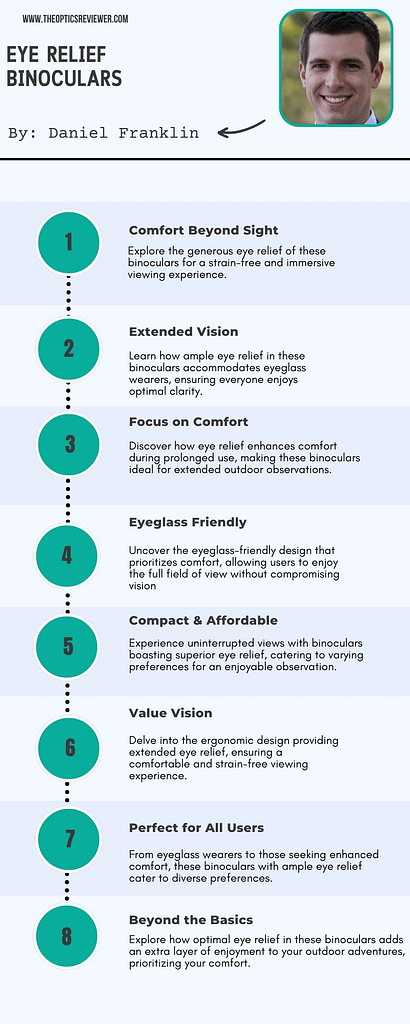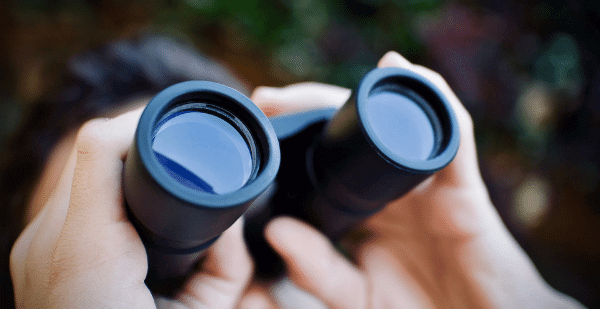If you are the one who wears glasses, then you must surely know the pain of using binoculars. Here the question arises should you stop using binoculars. Should you deprive yourself of using an essential outdoorsy tool? No way, you should use them for getting the best out of those beautiful but distant sceneries because here we are helping you with the best eye relief binoculars that would solve this problem of yours.
So, are you an outdoor enthusiast planning hiking those big mountains or seeing those surfers surfing on the oceans’ magnanimous waves? Or you are a nature lover who wants to go bird watching, nature sightseeing or acknowledge the beauty of the setting sun. Because no matter which one of these is you, if the relationship between your spectacles and binoculars isn’t complimentary, then indeed your field of view would be constricted, and you would miss out on some essential details of your view. And who wants that to happen? No one, Right?
Now you would be thinking why I should opt for eye relief binoculars when I can use any simple binocular with just removing my glasses. But my friend, frankly speaking, won’t it be annoying to swap your eyeglasses with binoculars again and again and who knows what crucial, once in a lifetime sighting you would miss in this swapping over. Do you want that to happen? Of course, no. Here we will provide you with a clear and detailed idea of eye relief and why it is vital in binoculars.
Contents
Key Takeaways
- Ample eye relief ensures a comfortable viewing experience, especially beneficial for extended use.
- Eyeglass wearers can enjoy a full field of view without sacrificing visual clarity.
- Binoculars with generous eye relief provide a versatile and accommodating solution for users with varying preferences.
- Enhanced comfort and reduced eye strain make these binoculars an ideal choice for all-day outdoor observations.
What is Eye Relief?
Firstly, let’s talk about what eye relief is. Eye relief is the optimum distance between your eyes and the eyepiece of the binoculars. More precisely, it is the distance from the eyepiece lens’s outer surface to the point where the exit pupil is formed. The viewer would be able to grasp the whole essence of the picture only if his eye is within this distance, and this is the principle on which eye relief binoculars work.
If the eye is closer to the eyepiece than this ideal distance, you won’t be able to get an edge-to-edge clarity, and dark shadows will appear around the outer edge resulting in a troubled field of view. If this distance is farther than the ideal eye relief distance, you won’t get the bigger picture, and your field of view would have vignetting. Not only this, but it would also put a strain on your eyes, resulting in your eyes getting tired and weary.
The more your eye is farther away from the eyepiece of the binoculars, the more constricted your field of view would be. Thus, instead of getting the ultra-sharp, magnified imaging experience, what you will get is a viewing experience that is no better than the sneak peek through a pinhole.
The minimum bar of eye relief in binoculars is set at 16mm, which ensures a bolstering view. The binoculars offering an eye relief of 15 mm or less cannot provide the best imaging to the eyeglass wearers but can be used by people who don’t wear glasses or wear contact lenses. With the advances in the binocular industry, many new eye relief binoculars have been introduced that have sufficiently long eye relief. Most specialists agree that in binoculars, the ideal eye relief for the people who wear glasses is approximately 17 to 20 mm to ensure that they can have the full view without any constraint.
As we know that the people suffering from long-sightedness or short-sightedness wear glasses to correct their vision anomalies, so here, diopter adjustment and the focusing system can play their part. They can fix mild ametropia (up to 1.5 diopters) and you don’t even have to wear eyeglasses in first place in this scenario.
Now the question arises that can the binoculars offering eye relief be used only by the eyeglass wearer? The answer is “No” both the eyeglass wearers and those who don’t wear eyeglasses can use the binocular options that provide eye-relief. The eyecups can be extended to achieve the ideal distance between the eye and eyepiece for those who don’t wear eyeglasses.

Short and Long Eye Relief
A binocular offering less than 13 mm of eye relief falls under the category of short eye relief binoculars, and it is not suitable for the ones who wear spectacles.
Binoculars offering 20-24 mm of eye relief are generally regarded as long eye relief options that provide a generously wide field of view without any restriction. One thing to keep in mind is that the binocular options offering such long eye relief are often expensive, and you have to invest more upfront for them.
Which particular eye relief binoculars you have to choose depend on your glasses’ size, thickness, and makeup along with your face shape. So, you should try different binocular options with your eyeglasses on to find the pair that best works for you.

How to Set Eye Relief of Binoculars?
- Firstly, you have to make the eyecup adjustment, so depending upon your binoculars’ model, you can either fold or twist down the eyecups.
- Now bring your face with those glasses of yours close to the eyepiece of binoculars and Ta-Da! That’s how simple it is to use eye relief binoculars.
Features to Look For in Binoculars
With the increase in demand for eye relief binoculars, many companies have introduced their innovative products that claim to be the best in their niche for eyeglass wearers. So, it can be tricky to find the best option that meets your budget and, at the same time, fulfill all your requirements. Therefore you should always try to look at different features a particular binocular is offering you. Some of them are:
- Adjustable Eyecups: Eyecups play an essential part in the deterrence of stray light to enter the eyepiece and prevent image distortion. In eyeglass wearers, the distance between the eyepiece and eye increases because of the presence of spectacles. The image won’t be formed on the retina, putting pressure and strain on the eye and displaying a low-quality image. In this scenario, eye relief binoculars that are equipped with adjustable eyecups play an essential part. Multi-position adjustable eyecups serve to ensure a comfortable view with or without glasses, as they can be twisted up or down to suit your requirement. Thus, you can fold in the eyecups to reduce the eye and eyepiece’s distance to get an excellent quality image, which is a desirable feature in binoculars for people with glasses.
- Magnification: Magnification refers to how many times a particular object seems closer to your eye than it is by using an optical device. There is an inverse relationship between the magnification and eye relief. The more you magnify a scene, the smaller your field of view and eye-relief would be. Thus, if you have a binocular with variable magnification, try its maximum and minimum field of view. Still, with binoculars having fixed magnification, you can adjust the eyecups for better sight.
- Field of View: The field of view is the whole width of the view you can see with your binoculars pair without moving your head. The wider the FOV is, the better you would be able to grasp the bigger picture. Most specialists agree that a 315 feet ratio at 1,000 yards would serve as a good FOV.
- Multi-coated Optics: Tired of color fringing, blurriness at the edges of the picture, or color aberrations? Then surely, you need to opt for eye relief binoculars that offer a fully multi-coated lens so that it can be anti-reflective and provides you with an excellent quality view in both bright and dim light.
- Weather-resistance: When you are already an eyeglass wearer, you know what it feels like when the drizzle makes your glasses all foggy. So, I believe that you don’t want to experience the same pain while using your binoculars. So the binoculars should also be waterproof, fog-proof, and shock-resistant to cope with harsh weather conditions.
- Quality: You should always view the quality of the binoculars, its construction, and its durability. No compromise should be made on binoculars quality because you can’t even entirely rely on the claims made by a low-quality cheap product, and you won’t be sure if the product can handle a few falls. Therefore we strongly recommend you use good quality eye relief binoculars that can stand the test of time.
- Price: Price is also an essential factor that drives your binoculars choice. We suggest you not go for a cheap option, because in most scenarios, the price of a product reflects the quality and features it offers. Think of it as a long-term investment because you never know by choosing a cheap product. You might end up spending more on repairs or replacement than investing in a pair of optically precise and substantially useful quality binoculars.
Conclusion
To cut a long story short, the next time you go for hiking, a road trip, or any other outdoor pursuit of yours, you don’t have to worry about compromising your image quality because of your spectacles. Because eye relief binoculars come as a savior for you, and you would be able to enjoy a sharper, brighter, and more clear view of the distant objects just like everyone else without any extra labor.
The fall season is just around the corner, and to relish the beauty of nature, eye relief binoculars are a must-have item.
FAQs
Q. What is eye relief?
Ans: Eye relief is the optimum distance between your eyes and the eyepiece of the binoculars. It is the distance from the eyepiece lens’s outer surface to where the exit pupil is formed. The viewer would be able to grasp the whole essence of the picture only if his eye is within this distance. If the eye is closer to the eyepiece than this ideal distance, you won’t be able to get an edge-to-edge clarity. If this distance is farther than the ideal eye relief distance, you won’t get the bigger picture.
Q. How is eye relief measured?
Ans: Eye relief is the distance from the rim of the eyepiece (the point where your eyes touch or in the case of eyeglass wearers, the point where the eyeglasses touch) to the point where the image forms.
Q. What is good eye relief for a pair of binoculars?
Ans: The minimum bar of eye relief in binoculars is set at 16 mm, which ensures a bolstering and crystal clear view for eyeglass wearers. The binoculars offering an eye relief of 15 mm or less cannot provide the best imaging to the eyeglass wearers but can be used by people who don’t wear glasses or wear contact lenses.
Q. What is diopter adjustment?
Ans: The diopter adjustment allows you to adjust your pair of binoculars according to your specific eyesight. The diopter knob or diopter adjustment ring adjusts for focal differences between your eyes. Thus it is useful for people with glasses and compensates for the difference between both eyes’ powers.
Q. How can I use diopter adjustment on my binoculars?
Ans: Start by setting the diopter adjustment at zero. now cover the objective lens of that side of the binoculars for which you want to do diopter adjustment. Rotate the diopter adjustment knob till you see a crystal clear image. Now repeat this process by covering the other side of the objective lens and fine focusing the image.

